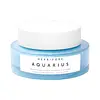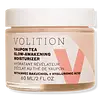What's inside
What's inside
 Key Ingredients
Key Ingredients

 Benefits
Benefits

 Concerns
Concerns

 Ingredients Side-by-side
Ingredients Side-by-side

Water
Skin ConditioningCaprylic/Capric Triglyceride
MaskingCetearyl Alcohol
EmollientGlycerin
HumectantSqualane
EmollientGlyceryl Caprylate
EmollientMicrocrystalline Cellulose
AbsorbentPropanediol
SolventSalix Nigra Bark Extract
Skin ProtectingZinc PCA
HumectantAloe Barbadensis Flower Extract
EmollientCamellia Sinensis Leaf Extract
AntimicrobialCoccinia Indica Fruit Extract
Skin ConditioningCorallina Officinalis Extract
Skin ConditioningCurcuma Longa Root Extract
MaskingHamamelis Virginiana Extract
AntiseborrhoeicMelia Azadirachta Flower Extract
Skin ConditioningMelia Azadirachta Leaf Extract
Skin ConditioningOcimum Basilicum Flower/Leaf Extract
TonicOcimum Sanctum Leaf Extract
Skin ConditioningSolanum Melongena Fruit Extract
Skin ConditioningTanacetum Annuum Flower Oil
MaskingLactobacillus Ferment
Skin ConditioningSodium Hyaluronate
HumectantSodium PCA
HumectantMagnesium PCA
HumectantSodium Stearoyl Glutamate
CleansingCellulose Gum
Emulsion StabilisingGlyceryl Stearate Citrate
EmollientCaprylyl Glyceryl Ether
CleansingCaprylhydroxamic Acid
Water, Caprylic/Capric Triglyceride, Cetearyl Alcohol, Glycerin, Squalane, Glyceryl Caprylate, Microcrystalline Cellulose, Propanediol, Salix Nigra Bark Extract, Zinc PCA, Aloe Barbadensis Flower Extract, Camellia Sinensis Leaf Extract, Coccinia Indica Fruit Extract, Corallina Officinalis Extract, Curcuma Longa Root Extract, Hamamelis Virginiana Extract, Melia Azadirachta Flower Extract, Melia Azadirachta Leaf Extract, Ocimum Basilicum Flower/Leaf Extract, Ocimum Sanctum Leaf Extract, Solanum Melongena Fruit Extract, Tanacetum Annuum Flower Oil, Lactobacillus Ferment, Sodium Hyaluronate, Sodium PCA, Magnesium PCA, Sodium Stearoyl Glutamate, Cellulose Gum, Glyceryl Stearate Citrate, Caprylyl Glyceryl Ether, Caprylhydroxamic Acid
Water
Skin ConditioningPropanediol
SolventGlycerin
HumectantHamamelis Virginiana Water
AstringentIlex Vomitoria Leaf Powder
Skin ConditioningIlex Aquifolium Leaf Extract
Skin ConditioningSodium Hyaluronate
HumectantBakuchiol
AntimicrobialMelia Azadirachta Flower Extract
Skin ConditioningMelia Azadirachta Leaf Extract
Skin ConditioningCorallina Officinalis Extract
Skin ConditioningCoccinia Indica Fruit Extract
Skin ConditioningEclipta Prostrata Extract
Skin ConditioningCoffea Arabica Seed Extract
MaskingCamellia Sinensis Leaf Extract
AntimicrobialLavandula Angustifolia Flower/Leaf/Stem Extract
MaskingPyrus Malus Fruit Extract
Skin ConditioningRubus Idaeus Fruit Extract
AstringentSalvia Officinalis Leaf Extract
CleansingCitrus Limon Peel Extract
EmollientCucumis Melo Fruit Extract
Skin ConditioningRosmarinus Officinalis Leaf Extract
AntimicrobialVaccinium Macrocarpon Fruit Extract
AstringentCucumis Melo Cantalupensis Fruit Extract
AstringentCucumis Sativus Fruit Extract
EmollientRose Extract
Skin ConditioningGlycine Soja Oil
EmollientBetaine
HumectantPotassium Sorbate
PreservativeSodium Benzoate
MaskingCaprylic/Capric Triglyceride
MaskingSucrose
HumectantTriethyl Citrate
MaskingLinalool
PerfumingCapryloyl Glycerin/Sebacic Acid Copolymer
Skin ConditioningGlyceryl Caprylate
EmollientIsododecane
EmollientAcrylates/C10-30 Alkyl Acrylate Crosspolymer
Emulsion StabilisingDiheptyl Succinate
EmollientSodium Hydroxide
BufferingMenthoxypropanediol
MaskingAlcohol
AntimicrobialCaprylhydroxamic Acid
Polysilicone-11
Decyl Glucoside
CleansingSodium Phytate
Lauryl Glucoside
CleansingCitric Acid
BufferingAcacia Senegal Gum
MaskingMaltodextrin
AbsorbentAmyl Cinnamal
PerfumingSodium Ascorbate
AntioxidantCI 75130
Cosmetic ColorantTocopherol
AntioxidantSilica
AbrasiveWater, Propanediol, Glycerin, Hamamelis Virginiana Water, Ilex Vomitoria Leaf Powder, Ilex Aquifolium Leaf Extract, Sodium Hyaluronate, Bakuchiol, Melia Azadirachta Flower Extract, Melia Azadirachta Leaf Extract, Corallina Officinalis Extract, Coccinia Indica Fruit Extract, Eclipta Prostrata Extract, Coffea Arabica Seed Extract, Camellia Sinensis Leaf Extract, Lavandula Angustifolia Flower/Leaf/Stem Extract, Pyrus Malus Fruit Extract, Rubus Idaeus Fruit Extract, Salvia Officinalis Leaf Extract, Citrus Limon Peel Extract, Cucumis Melo Fruit Extract, Rosmarinus Officinalis Leaf Extract, Vaccinium Macrocarpon Fruit Extract, Cucumis Melo Cantalupensis Fruit Extract, Cucumis Sativus Fruit Extract, Rose Extract, Glycine Soja Oil, Betaine, Potassium Sorbate, Sodium Benzoate, Caprylic/Capric Triglyceride, Sucrose, Triethyl Citrate, Linalool, Capryloyl Glycerin/Sebacic Acid Copolymer, Glyceryl Caprylate, Isododecane, Acrylates/C10-30 Alkyl Acrylate Crosspolymer, Diheptyl Succinate, Sodium Hydroxide, Menthoxypropanediol, Alcohol, Caprylhydroxamic Acid, Polysilicone-11, Decyl Glucoside, Sodium Phytate, Lauryl Glucoside, Citric Acid, Acacia Senegal Gum, Maltodextrin, Amyl Cinnamal, Sodium Ascorbate, CI 75130, Tocopherol, Silica
Ingredients Explained
These ingredients are found in both products.
Ingredients higher up in an ingredient list are typically present in a larger amount.
Camellia Sinensis Leaf Extract is derived from the leaves of the tea plant. Black tea, green tea, and oolong tea are all harvested from this plant.
This ingredient has many skin benefits:
This ingredient contains polyphenols, a strong antioxidant. Antioxidants help fight off molecules that damage skin cells.
On top of that, the antioxidants in green tea neutralize free-radicals from the sun. This gives the skin some extra UV protection, but should not replace sunscreen.
Many components of tea have anti-inflammatory properties.
Polyphenols and L-theanine help soothe the skin and reduce irritation. The caffeine in Camellia Sinensis Leaf Extract helps calm inflamed blood vessels.
Other compounds found in tea include: Vitamin Bs, linoleic acid, magnesium, calcium, iron, and zinc.
Research has shown both drinking Camellia Sinensis Leaf Tea and applying it to the skin can help boost skin elasticity and hydration. Studies also show using tea extract may reduce sebum, or oil, production.
Learn more about Camellia Sinensis Leaf ExtractCaprylhydroxamic Acid is a chelating agent.
Chelating agents help prevent metal ions from binding to other ingredients. This helps prevent unwanted reactions and effects from using the product.
Caprylhydroxamic Acid is often used with natural antimicrobial products as an alternative to preservatives.
Learn more about Caprylhydroxamic AcidThis ingredient is an emollient, solvent, and texture enhancer. It is considered a skin-softener by helping the skin prevent moisture loss.
It helps thicken a product's formula and makes it easier to spread by dissolving clumping compounds.
Caprylic Triglyceride is made by combining glycerin with coconut oil, forming a clear liquid.
While there is an assumption Caprylic Triglyceride can clog pores due to it being derived from coconut oil, there is no research supporting this.
Learn more about Caprylic/Capric TriglycerideCoccinia Indica Fruit Extract is also known as Ivy Gourd Fruit Extract. It has skin conditioning properties.
Corallina Officinalis Extract is from the red seaweed, Corallina Officinalis. This seaweed is found all over the world but is most common in the rocky shores of Great Britain and Ireland.
Corallina Officinalis Extract contains antioxidant and emollient properties.
Extracted polysaccharides, galactose and xylose, in red algae showed antioxidant activity. Antioxidants help with anti-aging by neutralizing free-radical molecules. Free-radical molecules may damage your skin cells and DNA. Galactose is also a PHA.
Corallina Officinalis is structurally similar to coral due to its high calcium content.
Learn more about Corallina Officinalis ExtractGlycerin is already naturally found in your skin. It helps moisturize and protect your skin.
A study from 2016 found glycerin to be more effective as a humectant than AHAs and hyaluronic acid.
As a humectant, it helps the skin stay hydrated by pulling moisture to your skin. The low molecular weight of glycerin allows it to pull moisture into the deeper layers of your skin.
Hydrated skin improves your skin barrier; Your skin barrier helps protect against irritants and bacteria.
Glycerin has also been found to have antimicrobial and antiviral properties. Due to these properties, glycerin is often used in wound and burn treatments.
In cosmetics, glycerin is usually derived from plants such as soybean or palm. However, it can also be sourced from animals, such as tallow or animal fat.
This ingredient is organic, colorless, odorless, and non-toxic.
Glycerin is the name for this ingredient in American English. British English uses Glycerol/Glycerine.
Learn more about GlycerinGlyceryl Caprylate comes from glycerin and caprylic acid, a fatty acid from coconut. It has emollient and emulsifier properties.
As an emollient, it helps hydrate your skin. Emollients work by creating a barrier on your skin to trap moisture in, helping to keep your skin soft and smooth.
On the other hand, emulsifiers prevent ingredients (such as oil and water) from separating.
Learn more about Glyceryl CaprylateMelia Azadirachta Flower Extract is from the Neem tree. Neem trees originate from India.
Melia Azadirachta Flower Extract contains antioxidants. Antioxidants help fight free-radicals. Free-radicals are molecules that may damage your skin cells, such as pollution.
The flowers of this tree are lilac colored.
Learn more about Melia Azadirachta Flower ExtractMelia Azadirachta Leaf Extract is extract from the neem plant.
The leaves of this tree contain flavonoids and polyphenols. These two compounds are antioxidants, anti-inflammatory, and antibacterial. Further research is needed as to their effects when applied on skin.
Propanediol is an all-star ingredient. It softens, hydrates, and smooths the skin.
It’s often used to:
Propanediol is not likely to cause sensitivity and considered safe to use. It is derived from corn or petroleum with a clear color and no scent.
Learn more about PropanediolSodium Hyaluronate is hyaluronic acid's salt form. It is commonly derived from the sodium salt of hyaluronic acid.
Like hyaluronic acid, it is great at holding water and acts as a humectant. This makes it a great skin hydrating ingredient.
Sodium Hyaluronate is naturally occurring in our bodies and is mostly found in eye fluid and joints.
These are some other common types of Hyaluronic Acid:
Learn more about Sodium HyaluronateWater. It's the most common cosmetic ingredient of all. You'll usually see it at the top of ingredient lists, meaning that it makes up the largest part of the product.
So why is it so popular? Water most often acts as a solvent - this means that it helps dissolve other ingredients into the formulation.
You'll also recognize water as that liquid we all need to stay alive. If you see this, drink a glass of water. Stay hydrated!
Learn more about Water